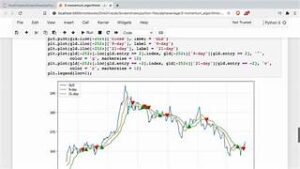Algo Trading Strategy for Beginners | How to Make Money in Share Market?
Algo Trading Strategy for Beginners
Algo Trading Strategy for Beginners | How to Make Money in Share Market? Making money in the stock market requires a combination of knowledge, research, strategy, discipline, and risk management. market While there is no guaranteed way to make money in the stock market
Algorithmic trading (ALGO trading) refers to the use of computer algorithms to automate trading decisions and executions in financial markets. Algo Trading Strategy for Beginners | How to Make Money in Share Market? These algorithms can be based on various strategies, each with its own goals and characteristics. Here are some common algorithmic trading strategies:
- Trend Following: This strategy involves identifying and trading in the direction of prevailing market trends. Algorithms analyze historical price data to identify upward or downward trends. When a trend is identified, the algorithm executes trades in the direction of the trend. Moving averages, trendlines, and other technical indicators are often used to determine trend direction and entry/exit points.
- Mean Reversion: Mean reversion strategies are based on the idea that asset prices tend to revert to their historical average over time. Algorithms monitor deviations from the mean and execute trades when prices move too far away from the average. This strategy assumes that extreme price movements will eventually reverse.
- Arbitrage: Arbitrage strategies take advantage of price discrepancies for the same asset across different markets or exchanges. Algorithms identify price differentials and execute trades to profit from these discrepancies before they are corrected.
- Statistical Arbitrage: This strategy involves trading pairs of assets based on their statistical relationship. Algorithms look for patterns in historical price data, such as co-movements or spreads between two related assets. When deviations occur from the established statistical relationship, the algorithm executes trades to capitalize on the expected convergence.
- Market Making: Market-making algorithms provide liquidity to the market by placing both buy and sell orders for a specific asset. The goal is to profit from the spread between the bid and ask prices. These algorithms continuously adjust their quotes based on market conditions to maintain a balance between buying and selling.
- Sentiment Analysis: Sentiment analysis algorithms monitor news, social media, and other sources to gauge market sentiment. Positive or negative sentiment can influence asset prices. These algorithms attempt to predict market movements based on the prevailing sentiment.
- High-Frequency Trading (HFT): HFT strategies involve executing a large number of trades at very high speeds. Algorithms analyze market data and execute trades in fractions of a second to profit from small price discrepancies. This strategy requires powerful technology and low-latency connections.
- Machine Learning and AI-Based Strategies: Algorithms using machine learning and artificial intelligence analyze vast amounts of data to identify patterns and make predictions. These strategies can adapt to changing market conditions and learn from past performance.
- Pairs Trading: Pairs trading involves trading a pair of correlated assets. Algorithms identify deviations in the relationship between the two assets and execute trades to capitalize on these deviations. When the relationship normalizes, profits are made.
- Volatility Trading: Volatility-based strategies focus on exploiting fluctuations in market volatility. Algorithms use volatility indicators to identify periods of high or low volatility and adjust trading strategies accordingly.
Remember that algorithmic trading involves risk, and not all strategies will be profitable in all market conditions. Algo Trading Stratagies Successful algorithmic trading requires careful strategy development, robust testing, risk management, and continuous monitoring and adjustment. Additionally, regulatory and ethical considerations are important when deploying algorithmic trading strategies.
Follow On Youtube :- @tradewithakanksha
How to Make Money in Share Market?
Making money in the stock market requires a combination of knowledge, research, strategy, discipline, and risk management. how to make money in stock market While there is no guaranteed way to make money in the stock market, here are some steps and tips that can help you increase your chances of success:
- Education and Research: Start by learning about the basics of the stock market, different investment instruments (stocks, bonds, ETFs, etc.), and how markets work. Understanding financial statements, market trends, and economic indicators will be valuable.
- Set Clear Goals: Determine your investment goals and risk tolerance. Are you looking for short-term gains or long-term growth? Different strategies align with different goals.
- Develop a Strategy: Based on your goals, develop an investment strategy. This might involve choosing between value investing, growth investing, dividend investing, or a combination of strategies.
- Diversification: Don’t put all your money into a single stock. Diversify your portfolio across different sectors and industries to reduce risk. Consider diversifying across asset classes as well, including stocks, bonds, and other investment vehicles.
- Research and Analysis: Before investing in a stock, thoroughly research the company’s financials, management, industry trends, and competitive landscape. Technical analysis (price and volume patterns) and fundamental analysis (financial data) can both provide insights.
- Long-Term Perspective: While there’s potential for short-term gains, a long-term perspective often yields better results. Over time, the stock market tends to reward patient investors.
- Risk Management: Only invest money you can afford to lose. Set stop-loss orders to limit potential losses. Avoid investing on a whim or based solely on emotions.
- Stay Informed: Keep up with financial news, economic indicators, and company announcements that could impact your investments.
- Avoid Herd Mentality: Just because everyone is investing in a certain stock doesn’t mean it’s the right choice. Avoid making decisions solely based on what others are doing.
- Control Emotions: Fear and greed can drive poor investment decisions. Stick to your strategy and don’t let emotions dictate your trades.
- Consider Dollar-Cost Averaging: Instead of investing a lump sum all at once, consider spreading your investments over time through dollar-cost averaging. This can help reduce the impact of market volatility.
- Utilize Investment Vehicles: Consider using investment vehicles like exchange-traded funds (ETFs) or mutual funds that offer exposure to a diversified portfolio.
- Stay Patient: The stock market goes through ups and downs. It’s important to stay patient and not panic during market downturns.
- Learn from Mistakes: It’s possible that you’ll make investment mistakes along the way. Learn from them and adapt your strategy accordingly.
- Consult Professionals: If you’re unsure about investing, consider seeking advice from financial advisors who can provide personalized guidance based on your financial situation and goals.
Remember that the stock market involves risk, and there are no guaranteed. How to Make Money in Share Market It’s important to approach investing with a realistic mindset and a willingness to learn and adapt. Algo Trading Strategy for Beginners | How to Make Money in Share Market?
Algorithmic trading (Algo trading) involves using computer algorithms to automate the process of making trading decisions and executing trades in financial markets. This approach relies on predefined rules and strategies to determine when to buy, sell, or hold financial instruments like stocks, currencies, commodities, or derivatives. Algo Trading Strategy for Beginners | How to Make Money in Share Market?
Here are the basic steps involved in algo trading:
- Strategy Development: Begin by defining your trading strategy. This could be based on technical indicators, fundamental analysis, quantitative models, or a combination of factors. The strategy should include specific entry and exit criteria.
- Coding the Algorithm: Write a computer program or algorithm that implements your trading strategy. This program should take into account market data, such as price, volume, and other relevant information, and use it to make trading decisions.
- Backtesting: Before deploying your algorithm in real-time, test it using historical market data to see how it would have performed in the past. This helps identify potential flaws or weaknesses in the strategy.
- Optimization: Based on the results of backtesting, you might need to fine-tune your algorithm. This could involve adjusting parameters, refining rules, or changing the strategy altogether to improve performance.
- Risk Management: Implement risk management techniques within your algorithm to limit potential losses. This might involve setting stop-loss orders, position sizing rules, or other safeguards.
- Execution: Once you’re satisfied with the performance during backtesting, deploy the algorithm in real-time trading. The algorithm will continuously monitor market data and execute trades according to the predefined strategy.
- Monitoring and Maintenance: Regularly monitor the algorithm’s performance and make necessary adjustments as market conditions change. Algorithms might need updating to adapt to new trends or unexpected events.
- Market Connectivity: Establish a connection to a trading platform or exchange that allows your algorithm to execute trades. This might involve using APIs (Application Programming Interfaces) provided by the exchange.
- Data Feed Integration: Algorithms require accurate and up-to-date market data to function effectively. Integrate a reliable data feed that provides the necessary information for your trading strategy.
- Regulatory Compliance: Ensure that your algorithmic trading activities comply with relevant regulations and rules set by regulatory authorities. Some regions have specific requirements for algorithmic trading.
- Testing in Simulated Environments: Before deploying an algorithm in real trading, consider testing it in a simulated or paper-trading environment to gain more confidence in its performance without risking real capital.
- Continuous Learning: The market is dynamic and constantly evolving. Stay informed about market trends, new strategies, and changes in market conditions to adapt your algorithm accordingly.
It’s important to note that algorithmic trading carries risks, and not all strategies will be profitable in all market conditions. Algo Trading Strategy for Beginners Moreover, technical glitches or unforeseen events can impact algorithmic trading systems. It’s advisable to start with small capital and gradually increase exposure as you gain more experience and confidence in your algorithmic trading strategy.
Algorithmic options trading refers to the use of automated computer programs to execute trading strategies involving options contracts. Options are financial derivatives that give the holder the right, but not the obligation, to buy or sell an underlying asset at a predetermined price (strike price) within a specified time period.
Algo Trading
Follow On Youtube :- @tradewithakanksha
Algorithmic trading involves writing algorithms that can analyze market data, identify trading opportunities, and execute trades without human intervention. Algo Trading Strategy for Beginners | How to Make Money in Share Market? Here’s a basic overview of how algorithmic options trading works:
- Data Collection: Algorithms collect real-time market data, including options prices, underlying asset prices, volatility, trading volume, and other relevant information.
- Strategy Development: Traders and programmers develop trading strategies based on specific criteria, such as technical indicators, price patterns, volatility levels, and fundamental analysis. The algorithm’s decision-making process is programmed based on these strategies.
- Algorithm Implementation: The trading algorithm processes the collected data and generates trading signals. These signals indicate when to buy or sell options contracts based on the chosen strategy.
- Risk Management: Risk management rules are integrated into the algorithm to control the size of trades, limit potential losses, and protect the trading capital. This can involve setting stop-loss orders, position size limits, and other safeguards.
- Trade Execution: Once a trading signal is generated, the algorithm automatically executes the corresponding trade. This can involve buying or selling options contracts on various exchanges.
- Monitoring and Adjustment: Algorithms continuously monitor the market and the performance of open trades. If market conditions change or the trade is not performing as expected, the algorithm may adjust the trade or exit positions.
Benefits of Algorithmic Options Trading:
- Speed and Efficiency: Algorithms can execute trades much faster than human traders, taking advantage of fleeting opportunities in the options market.
- Elimination of Emotions: Algorithms trade based on predefined rules, removing emotions from the decision-making process and reducing the impact of impulsive decisions.
- Backtesting: Algorithms can be tested on historical data to assess their performance before being deployed in real-time trading.
- 24/7 Trading: Algorithms can trade around the clock, reacting to market developments even when human traders are not available.
- Diversification: Algorithms can manage multiple trades simultaneously across different options contracts and strategies.
Algo Trading Strategy for Beginners | How to Make Money in Share Market? However, it’s important to note that algorithmic trading carries its own risks and challenges, such as technical glitches, sudden market changes, and over-optimization of strategies. Traders need to have a deep understanding of options markets, trading strategies, and programming to effectively design, implement, and manage algorithmic options trading systems. Additionally, proper risk management is crucial to protect capital and prevent large losses.






